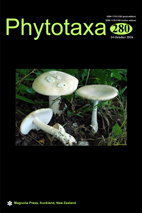Abstract
Two taxa of Marasmius sect. Marasmius are herein (re)described, reported from the Amazon forest. Marasmius calvocystidiatus is proposed as a new species on account of its glabrous (bald) pileus with smooth cystidia, some of them lobed or with coarse excrescences in the pileipellis. On the other hand, the only taxon of sect. Marasmius subsect. Horriduli, Marasmius horridulus is redescribed herein, highlighting its “hairy” pileus (similar to Crinipellis species) with abundant, dextrinoid, setiform hairs rising from a hymeniform to subhymeniform pileipellis composed of anomalous broom-cells. Molecular evidence (based on ITS data) indicates that both taxa indeed belong to Marasmius sensu stricto, and are immediate sister to each other in trees reconstructed by phylogenetic analyses accomplished in this study. Our phylogenetic hypothesis also suggests that M. calvocystidiatus and M. horridulus are close to M. purpureisetosus, a species with sparse setiform hairs and also anomalous thick-walled broom cells in the pileipellis, and to a group of species members of sect. Marasmius subsect. Rotalis. In this paper we present morphological descriptions, line drawings, color plates and a phylogenetic hypothesis in support of our findings for M. calvocystidiatus and M. horridulus.

